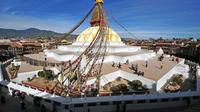Kathmandu Full Day Tour
Kathmandu, Nepal
Rating: 









Trip Type: Full-day Tours
Duration: 1 day
Kathmandu day tour Includes - Kathmandu Durbar Squire, Swayambhunath, Pasupatinath and Bouddhanath are included on this day tour.
More About This Activity All Full-day Tours →
Kathmandu day tour Includes - Kathmandu Durbar Squire, Swayambhunath, Pasupatinath and Bouddhanath are included on this day tour. We will first visit Kathmandu Durbar Square. Kathmandu Durbar Square is situated in the heart of old Kathmandu city at Basantapur, it never fails to impress first time visitors with its ensemble of palaces, courtyards and temples built during the Malla period. The Durbar Square includes the Hanuman Dhoka Royal Palace, the historic seat of the royalty; the magnificent Taleju Temple towering more than 40 meters; Kumari Ghar, the residence of the Living Goddess, Kumari; Ashok Vinayak, also called Kathmandu Ganesh, a temple without a filial ; and Kal Bhairav, the God of Wrath. The capital takes its name from the giant pagoda of Kasthamandap, which is said to have been built out of a single tree. Since the time of the Malla kings, the Durbar Square has been the city’s social, religious and political focal point.
We will then visit Swayambhunath, which is located on a hillock 3 km west of Kathmandu, it is one of the holiest Buddhist Chaityas in Nepal. It is said to have evolved spontaneously when the valley was created out of a primordial lake more than 2,000 years ago. This stupa is the oldest of its kind in Nepal and has numerous shrines and monasteries on its premises.
In the afternoon we will drive to Pasupatinath Temple which is located 5 km east of Kathmandu, the temple of Lord Shiva is considered one of the most sacred Hindu shrines in the world. The two-tiered pagoda with golden roofs and silver doors houses the sacred linga, or phallic symbol, of Lord Shiva. Chronicles indicate the temple existed before 400 A.D. Near the Pashupatinath Temple on the banks of the Bagmati River lies Guheswari, where, according to mythology, a portion of Sati Devi, Lord Shiva’s consort, fell when a grief-stricken Shiva wandered aimlessly across the earth carrying her dead body on his shoulders following her self-immolation.
Last place we will visit will be Bouddhanath Stupa which is located 8km to the east of downtown Kathmandu, Bauddhanath is one of the most imposing landmarks in Kathmandu, visible as soon as you land at the Tribhuvan International Airport. It is the largest stupa in the Kathmandu Valley and is the center of Tibetan Buddhism.
We will then visit Swayambhunath, which is located on a hillock 3 km west of Kathmandu, it is one of the holiest Buddhist Chaityas in Nepal. It is said to have evolved spontaneously when the valley was created out of a primordial lake more than 2,000 years ago. This stupa is the oldest of its kind in Nepal and has numerous shrines and monasteries on its premises.
In the afternoon we will drive to Pasupatinath Temple which is located 5 km east of Kathmandu, the temple of Lord Shiva is considered one of the most sacred Hindu shrines in the world. The two-tiered pagoda with golden roofs and silver doors houses the sacred linga, or phallic symbol, of Lord Shiva. Chronicles indicate the temple existed before 400 A.D. Near the Pashupatinath Temple on the banks of the Bagmati River lies Guheswari, where, according to mythology, a portion of Sati Devi, Lord Shiva’s consort, fell when a grief-stricken Shiva wandered aimlessly across the earth carrying her dead body on his shoulders following her self-immolation.
Last place we will visit will be Bouddhanath Stupa which is located 8km to the east of downtown Kathmandu, Bauddhanath is one of the most imposing landmarks in Kathmandu, visible as soon as you land at the Tribhuvan International Airport. It is the largest stupa in the Kathmandu Valley and is the center of Tibetan Buddhism.
« Go Back

